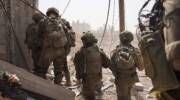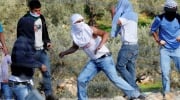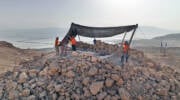A recent archaeological excavation in Modi’in, which uncovered a rare cache of silver coins, provides more evidence of vibrant Jewish life in ancient Israel and to the Jewish revolt against the Romans in the Hasmonean era.
An excavation by the Israel Antiquities Authority led to the discovery of a rare cache of silver coins dating to the Hasmonean period in the central city of Modi‘in.
The excavation, with the participation of local youth, is being carried out prior to the construction of a new neighborhood at the initiative of the Modi‘in-Maccabim-Re‘ut municipality. The treasure was hidden in a rock crevice, up against a wall of an impressive agricultural estate that was discovered during the excavation.
“This is a rare cache of silver coins from the Hasmonean period comprised of shekels and half-shekels that were minted in the city of Tyre and bear the images of the king, Antiochus VII, and his brother, Demetrius II. The cache that we found is compelling evidence that one of the members of the estate who had saved his income for months needed to leave the house for some unknown reason. He buried his money in the hope of coming back and collecting it, but was apparently unfortunate and never returned,” explained Avraham Tendler, the IAA’s director of the excavation.
“It is exciting to think that the coin hoard was waiting here 2,140 years until we exposed it,” he said.
Furthermore, “The findings from our excavation show that a Jewish family established an agricultural estate on this hill during the Hasmonean period. The family members planted olive trees and vineyards on the neighboring hills and grew grain in valleys. An industrial area that includes an olive press and storehouses where the olive oil was kept is currently being uncovered next to the estate. Dozens of rock-hewn wine presses that reflect the importance of viticulture and the wine industry in the area were exposed in the cultivation plots next to the estate. The estate house was built of massive walls in order to provide security from the attacks of marauding bandits.
“Numerous bronze coins minted by the Hasmonean kings were also discovered in the excavation,” he continued. “They bear the names of the kings such as Yehohanan, Judah, Jonathan or Mattathias and his title: High Priest and Head of the Council of the Jews. The finds indicate that the estate continued to operate throughout the Early Roman period. The Jewish inhabitants of the estate meticulously adhered to the laws of ritual purity and impurity: they installed ritual baths (mikva’ot) in their settlement and used vessels made of chalk, which according to Jewish law cannot become ritually unclean.”
Evidence was discovered at the site suggesting that the residents of the estate also participated in the first revolt against the Romans that broke out in 66 CE: the coins that were exposed from this period are stamped with the date “Year Two” of the revolt and the slogan “Freedom of Zion.” The estate continued to operate even after the destruction of the Holy Temple in 70 CE.
“It seems that local residents did not give up hope of gaining their independence from Rome, and they were well-prepared to fight the enemy during the Bar Kokhba uprising”, said Tendler. “During the excavation we saw how prior to the uprising the inhabitants of the estate filled the living rooms next to the outer wall of the building with large stones, thus creating a fortified barrier. In addition, we discovered hiding refuges that were hewn in the bedrock beneath the floors of the estate house. These refuge complexes were connected by means of tunnels between water cisterns, storage pits and hidden rooms. In one of the adjacent excavation areas, a mikva of impressive beauty was exposed; when we excavated deeper in the bath, we discovered an opening inside it that led to an extensive hiding refuge in which numerous artifacts were found that date to the time of the Bar Kokhba uprising.”
According to Dr. Donald Tzvi Ariel, the head of the Coin Department at the Israel Antiquities Authority, “The cache, which consists of 16 coins, contains one or two coins from every year between 135–126 BCE, and a total of nine consecutive years are represented. It seems that some thought went into collecting the coins, and it is possible that the person who buried the cache was a coin collector. He acted in just the same way as stamp and coin collectors manage collections today.”
The unique finds revealed in the excavation will be preserved in an archaeological park in the heart of the new neighborhood slated for construction in Modi‘in-Maccabim-Re‘ut.
Courtesy: Israel Government Press Office

Free Ebook: 10 Best Places to Visit in Israel
The Land of Israel has provided the backdrop for some of the most important events in human history. From the Old City in Jerusalem to the Sea of Galilee, people from all over the globe visit the Holy Land each year to take in the breathtaking scenery and inspiration of Israel. Now you can experience this beauty for yourself from the comforts of home and maybe plan a trip of your own to Israel. Get the free, exclusive eBook from United with Israel: The 10 Best Places to Visit in Israel.
Do You Love Israel? Make a Donation - Show Your Support!
Donate to vital charities that help protect Israeli citizens and inspire millions around the world to support Israel too!
Now more than ever, Israel needs your help to fight and win the war -- including on the battlefield of public opinion.
Antisemitism, anti-Israel bias and boycotts are out of control. Israel's enemies are inciting terror and violence against innocent Israelis and Jews around the world. Help us fight back!






















